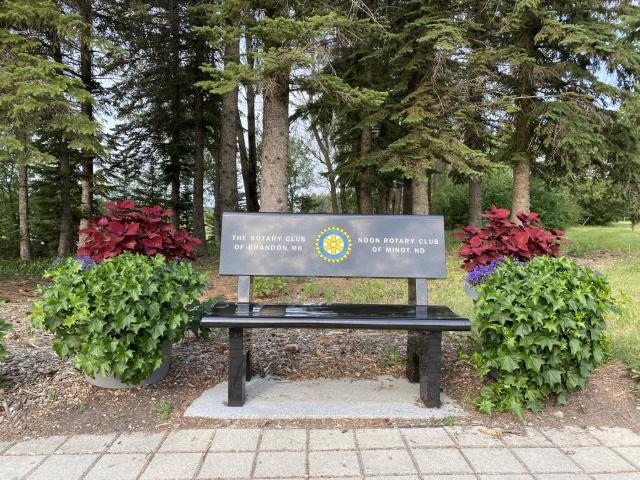International Peace Garden
Get In Contact
The International Peace Garden encompasses more than 2,300 acres of natural beauty, with two pristine freshwater lakes, scenic hiking and driving trails, wildflowers, waterfalls, and floral gardens that display colorful profusion of blooms every summer. The garden straddles the US-Canadian border and serves as a living testament to the lasting peace and friendship between the two nations.
The Stone Cairn marking the US-Canada border was the first structure built in the International Peace Garden. Field stones were gathered from both sides of the border to build the cairn, which was dedicated on July 14, 1932. Over 50,000 people attended the dedication, which was a remarkable turnout considering the rough roads of the era. The size of the crowd showed enthusiasm for both the Garden itself and for the idea of a monument to peace.
A highlight of the attractions at the Garden is the Conservatory. Originally constructed in 2010, it was remodeled and expanded in 2021-24. The Conservatory houses the Don Vitko collection of cacti and succulents, with over 5,000 specimens including rare and endangered species from all around the world. The Conservatory building also houses a horticulture library, a summer café, and a gift shop featuring local art and collectibles.
The Children’s Nature Play Area provides children of all ages with an immersive experience exploring the world of animals native to the region. Each of the zones in the play area was developed to simulate the habitat of an animal important to the local environment, history and culture. In the beaver zone, dams and a lodge mimic the way the activities of the beavers shape the aquatic environment around them. The turtle area features climbing nets to encourage hands-on exploration. The wolf area has a fire ring surrounded by a sharing circle to honor the strong family and social ties of the wolf pack.
The Formal Gardens offer a stunning vista of terraces, walkways, fountains, reflecting pools, and colorful beds of flowers in displays designed around a new theme each year. The Canadian and American flags are also depicted in flowers. Over 100,000 flowers are planted each spring by garden staff and volunteers.
One of the iconic attractions in the Garden is the Floral Clock, a working clock 18 feet in diameter. The original clock installed in 1966 was a replica of the famous Bulova Floral Clock at Berne, Switzerland. It was replaced the summer of 2005 with a new clock from St. Louis, Missouri. It’s freshly planted each spring with a new design incorporating 2,000 to 5,000 plants. The clock’s mechanism is regulated by satellite through a GPS system.
The Peace Chapel is the only structure in the Garden built directly on the US-Canada border. Dozens of quotes etched in limestone are featured on the walls, including inspirational thoughts about peace from historical figures ranging from Benjamin Franklin, Alexander Graham Bell, Abraham Lincoln, and Louis Pasteur, to more modern leaders including Richard Nixon and John F. Kennedy. The limestones offer a lesson in natural history with embedded marine fossils from the tropical sea that covered the area millions of years ago.
The resonant tones of the Carillon Bell Tower ring out over the Garden every 15 minutes. The 14 bells range in size from 250 to 2,000 pounds, with a total weight of more than 20 tons. It’s one of only four sets of bells like it in the world. The tower that houses them was erected by the North Dakota Veterans Organization and is dedicated to war veterans.
The 9/11 Memorial was funded by Rotary International, North American Firefighters Union and Manitoba Infrastructure. It includes twisted iron girders from the collapsed towers at the World Trade Center. A memorial service is held each year at 11 AM on 9/11 to remember those who were lost, honor first responders, and rededicate us to the ideal of peace among nations.
The North American Game Warden Museum tells the story of the historical and present-day roles of wildlife law enforcement and natural resources conservation. It provides a hands-on experience through a wide variety of animal pelts, mounts, horns and antlers for visitors to see and touch.
The wood and stone used for the Historic Lodge embody the emphasis on local materials seen throughout the Garden. Built in 1937 from timber from Riding Mountain in Manitoba and granite from the Turtle Mountains in North Dakota, the lodge is 105 feet long with a 60-foot wing and features two massive stone fireplaces. Today the lodge is used for meetings, conventions, wedding receptions, annual events, family reunions and more.
Visitors often comment on the sense of serenity that pervades the Garden. Horticulturists and home gardeners alike often note the feeling of tranquility that’s created by proximity to and working with plants. They ground us to the earth we live on, and we depend on them for our survival. Plants and peace are inextricably bound together, and their profusion in the garden provides the ideal setting for not only admiring their beauty, but creating an atmosphere conducive to the garden’s purpose and mission of celebrating peace between nations.
All Features
-
Activities
- Guides Available,
- Self-guided Tours
-
Availability
- Open Year 'Round
-
Camping Amenities
- Electricity,
- RV Sites,
- Tenting,
- Water
-
Facility Amenities
- Historic Marker,
- Restaurant on site,
- Restrooms,
- Trails
-
General Information
- Family-Friendly,
- Pet-Friendly
-
Group & Meeting Information
- Accommodates Tour Groups,
- Advance Reservations Required for Groups,
- Group Rates Available
-
Location
- Countryside











